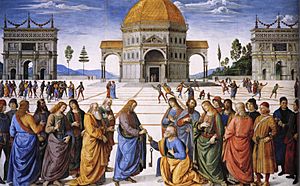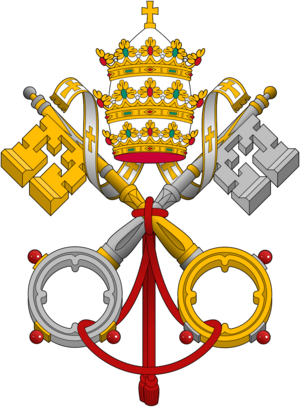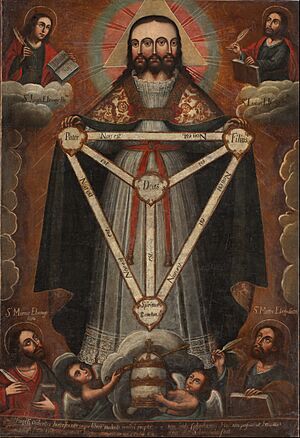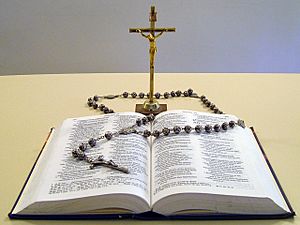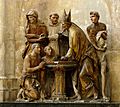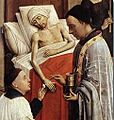Catholic Church facts for kids
Quick facts for kids Catholic Church |
|
|---|---|
| Ecclesia Catholica | |
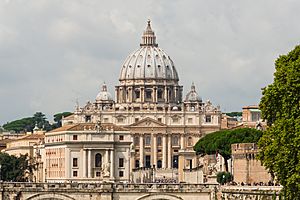
St. Peter's Basilica in Vatican City, the largest Catholic church building in the world
|
|
| Classification | Catholic |
| Scripture | Catholic Bible |
| Theology | Catholic theology |
| Polity | Papal supremacy - Episcopal |
| Governance | Holy See and Roman Curia |
| Pope | Francis |
| Particular churches sui iuris |
Latin Church and 23 Eastern Catholic Churches |
| Dioceses |
|
| Parishes | 221,700 approx. |
| Region | Worldwide |
| Language | Ecclesiastical Latin and native languages |
| Liturgy | Latin and Eastern |
| Headquarters | Vatican City |
| Founder |
|
| Origin | 1st century Judaea, Roman Empire |
| Separations |
|
| Members | 1.272 billion according to World Christian Database (2025) 1.406 billion according to the Annuario Pontificio (2023) |
| Clergy |
|
| Hospitals | 18,000 clinics 5,500 hospitals |
| Nursing homes | 16,000 |
| Primary schools | 95,200 |
| Secondary schools | 43,800 |
The Catholic Church, also known as the Roman Catholic Church, is the largest Christian church in the world. It has over 1.4 billion members worldwide. It is one of the oldest and largest international institutions and has played a big part in the history of Western civilization. The Church is made up of 24 self-governing churches, including the Latin Church and 23 Eastern Catholic Churches. These churches are divided into almost 3,500 areas called dioceses, each led by a bishop. The leader of the entire Church is the pope, who is also the bishop of Rome.
The main beliefs of Catholicism are in the Nicene Creed. The Catholic Church teaches that it was founded by Jesus Christ. It believes its bishops are the successors of Jesus's apostles, and the pope is the successor of Saint Peter. The Church says it follows the original Christian faith taught by the apostles. This faith is preserved through the Bible and sacred tradition.
The Church has seven sacraments, with the Eucharist being the most important. The Eucharist is celebrated during a service called the Mass. The Church teaches that a priest's blessing turns bread and wine into the body and blood of Christ. The Virgin Mary is highly respected as the Mother of God. The Church also runs thousands of schools, hospitals, and orphanages. It is the world's largest non-government provider of education and healthcare.
The Catholic Church has greatly influenced Western philosophy, culture, art, music, and science. For centuries, it was in communion with the Eastern Orthodox Church. They split in 1054 in an event called the East–West Schism. In the 16th century, the Reformation led to the creation of Protestant churches.
Name
The word Catholic comes from the Greek word katholikos, which means "universal". It was first used to describe the church in the early 2nd century. Saint Ignatius of Antioch wrote in a letter around 110 AD: "where Jesus may be, there is the universal [katholike] Church." This name was used to show that it was for everyone, everywhere.
After the East–West Schism in 1054, the church in the West became known as the Catholic Church, while the church in the East became the Eastern Orthodox Church. The name Roman Catholic Church became common in English after the Protestant Reformation in the 16th century. This was to distinguish it from the new Protestant churches.
Today, the official name used in church documents like the Catechism of the Catholic Church is simply the Catholic Church.
History
The time of the Apostles
The New Testament of the Bible tells the story of Jesus's life and teachings. It describes how he chose twelve apostles to continue his work. The Catholic Church teaches that its public work began on Pentecost. This was when the apostles received the Holy Spirit.
The Church believes that the college of bishops, led by the pope, are the successors to the apostles. In the Gospel of Matthew, Jesus calls Saint Peter the "rock" on which he will build his church. Because of this, the Catholic Church sees the pope, the bishop of Rome, as Peter's successor.
Ancient Rome and the Middle Ages
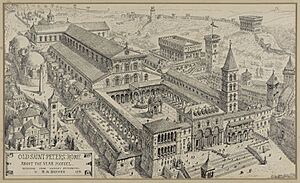
In the Roman Empire, good roads and safe travel helped spread new ideas like Christianity. At first, Christians were sometimes punished for not worshipping the Roman gods. But in 313 AD, Emperor Constantine the Great made Christianity legal with the Edict of Milan. Later, in 380 AD, it became the official religion of the empire.
During the Middle Ages, the Catholic Church had a huge influence on Western civilization. It preserved ancient knowledge in its monasteries. Monks and nuns copied books by hand, saving many important works of art and literature. The Church also started the first universities in Europe, such as the University of Oxford and the University of Paris.
In 1054, a major split called the East–West Schism happened. It divided the Church into the Catholic Church in the West and the Orthodox Church in the East. The split was caused by disagreements, mainly about the authority of the pope.
Renaissance and Reformation
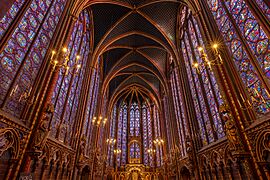
During the Renaissance, the Church sponsored many great artists like Michelangelo and Leonardo da Vinci. This period produced some of the world's most famous art and architecture.
In the 16th century, a movement called the Reformation began. A German friar named Martin Luther protested against some Church practices. This led to the creation of Protestant churches. In response, the Catholic Church began the Counter-Reformation. The Council of Trent was held to clarify Catholic teachings and make reforms.
During this time, known as the Age of Discovery, Catholic missionaries traveled the world. They spread the faith to the Americas, Asia, and Africa.
Enlightenment and Modern Times
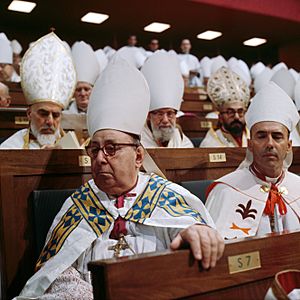
From the 17th century, a period called the Enlightenment began. Thinkers started to question the Church's influence. The French Revolution in 1789 led to a loss of power for the Church in France.
In 1870, the Kingdom of Italy took over the Papal States, which were lands ruled by the pope. This ended the pope's direct political power. The Roman question, a dispute over the pope's status, was settled in 1929 with the Lateran Treaty. This treaty created Vatican City as an independent state.
In the 1960s, Pope John XXIII called the Second Vatican Council. This council brought major changes to the Church. For example, it allowed the Mass to be said in local languages instead of only Latin. This was done to help people participate more fully.
Pope John Paul II, who was pope from 1978 to 2005, was known for his world travels. He played a role in the fall of communism in Eastern Europe.
How the Church is Organized
The Catholic Church is led by bishops, who are part of a structure called an episcopal polity. The leader of the entire Church is the pope.
The Pope and the Vatican

The head of the Catholic Church is the pope, who is currently Pope Leo XIV. The pope's office is called the papacy. He lives and works in Vatican City, an independent city-state inside Rome, Italy. The central government of the Church, which helps the pope, is called the Roman Curia.
When a pope dies or resigns, a new one is elected by the College of Cardinals. Cardinals are high-ranking church officials chosen by the pope. Only cardinals under the age of 80 can vote in a papal conclave to elect the next pope.
Churches, Dioceses, and Parishes
The Catholic Church is a communion of 24 autonomous churches. The largest is the Latin Church. The other 23 are known as the Eastern Catholic Churches. They have their own traditions and liturgies but are all in communion with the pope.
The world is divided into territories called dioceses, each led by a bishop. Dioceses are made up of smaller communities called parishes. A parish is a local church community, usually led by a priest.
Religious Institutes
Many Catholics join religious institutes, where they take vows of poverty, chastity, and obedience. These include orders of monks, nuns, friars, and sisters. Famous examples are the Benedictines, Franciscans, Dominicans, and Jesuits. These groups focus on prayer, teaching, and helping the poor and sick.
What Catholics Believe
Catholic beliefs have been developed over many centuries. They are based on the teachings of early Christians, the Bible, and church councils. The main beliefs are summarized in the Catechism of the Catholic Church.
God and Jesus
The Church teaches that there is one God who exists as three persons: God the Father, God the Son (Jesus Christ), and the Holy Spirit. This is known as the Holy Trinity.
Catholics believe that Jesus is the Son of God who became human. He was born of the Virgin Mary in an event called the Incarnation. He is both fully God and fully human. His mission was to teach people and set an example for them to follow. Catholics believe Jesus died on the cross to save humanity from sin and then rose from the dead.
The Church
The Catholic Church teaches that it is the "one, holy, catholic, and apostolic Church" founded by Jesus. It believes it holds the full means of salvation. The Church sees its purpose as continuing Jesus's presence on Earth. It helps people build a relationship with God through its teachings and sacraments.
The Virgin Mary
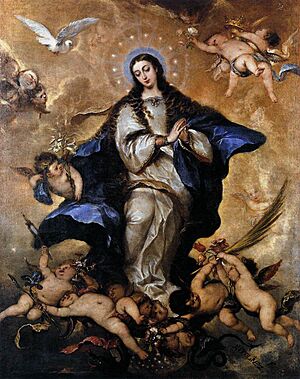
Mary, the mother of Jesus, has a special place in the Catholic Church. She is called the Mother of God and Queen of Heaven. Catholics believe she was conceived without original sin (the Immaculate Conception) and was taken directly to heaven at the end of her life (the Assumption of Mary).
Devotions to Mary, such as praying the Rosary, are common. Catholics ask her to pray for them, but they worship only God.
The Seven Sacraments

The Catholic Church has seven sacraments, which are seen as signs of God's grace. They were instituted by Christ to help people on their spiritual journey.
Sacraments of Initiation
These sacraments bring a person into the Church.
- Baptism: The first sacrament, which washes away sin and makes a person a member of the Church.
- Confirmation: This sacrament strengthens the grace of Baptism and gives the Holy Spirit.
- Eucharist: This is the central sacrament. Catholics believe the bread and wine become the body and blood of Christ. Receiving the Eucharist for the first time is called First Communion.
Sacraments of Healing
These sacraments offer spiritual healing.
- Penance (or Confession): A person confesses their sins to a priest and receives forgiveness from God.
- Anointing of the Sick: A priest anoints a person who is seriously ill, giving them comfort and strength.
Sacraments of Service
These sacraments are for specific roles in the Church.
- Holy Orders: The sacrament through which men become deacons, priests, or bishops.
- Matrimony: The sacrament of marriage, which unites a man and a woman in a lifelong bond.
Worship and Liturgy
Liturgy is the official public worship of the Church. There are many different liturgical traditions, called rites, within the Catholic Church. These reflect the cultural diversity of its members.
The most important liturgy is the Mass (or Divine Liturgy in the East), where the Eucharist is celebrated. The most common rite is the Roman Rite. After the Second Vatican Council, the Mass began to be celebrated in local languages so everyone could understand. Before that, it was almost always in Latin.
Eastern Catholic Churches have their own ancient rites, such as the Byzantine Rite and the Alexandrian Rite. These rites have different prayers, music, and ceremonies, but they share the same core beliefs as the Latin Church.
Social and Cultural Issues
Helping Others

Catholic social teaching emphasizes helping the poor, the sick, and those in need. This is based on Jesus's concern for the poor. The Church teaches about the importance of social justice and the dignity of every person.
The Church runs one of the largest networks of social services in the world. This includes schools, universities, hospitals, orphanages, and charities like Caritas Internationalis and Catholic Relief Services. These organizations provide aid to people of all backgrounds around the globe.
Marriage and Family
The Church teaches that marriage is a special bond between a man and a woman. It is seen as the foundation of the family and the proper setting for raising children. The Church's teachings on family life are an important part of its social doctrine.
Women in the Church
Women have always played important roles in the Catholic Church. Many women join religious institutes as nuns or sisters. They work in teaching, healthcare, and as missionaries. While women are not ordained as priests, they contribute to the life of the Church in many other ways.
Images for kids
-
The Last Supper by Leonardo da Vinci shows Jesus's final meal with his apostles.
-
A painting of St. Catherine of Siena. She was a mystic who helped end a major division in the Church in the 14th century.
-
A painting showing the glory of Saint Ignatius of Loyola, founder of the Jesuits.
-
A painting of Our Lady of Guadalupe, a famous Marian apparition in Mexico.
-
Canadian soldiers meet Pope Pius XII in 1944 after the liberation of Rome in World War II.
-
Pope John Paul II meets with U.S. President Ronald Reagan in 1982. Both were credited with helping to end the Cold War.
-
A wedding in the Syro-Malabar Catholic Church in India, one of the Eastern Catholic Churches.
-
In 2015, Pope Francis wrote an important letter called Laudato si' about protecting the environment.
-
An allegory of chastity by Hans Memling.
-
Pope Paul VI issued Humanae vitae in 1968, a letter about family life and marriage.
-
A sculpture showing the Baptism of Augustine of Hippo in Troyes Cathedral, France.
-
Pope Benedict XVI celebrates the Eucharist in São Paulo, Brazil, in 2007.
-
A painting by Rogier van der Weyden from 1445 showing the sacrament of Anointing of the Sick.
-
A wedding Mass in the Philippines.
See also
 In Spanish: Iglesia católica para niños
In Spanish: Iglesia católica para niños



